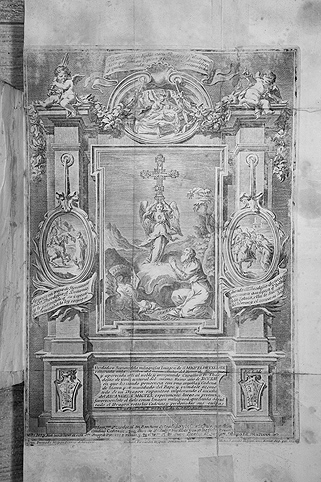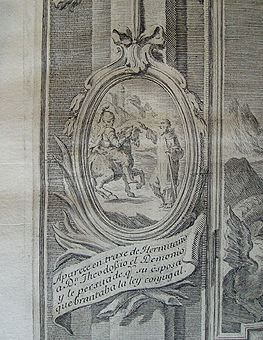The piece of the month of July 2007
ENGRAVING OF SAN MIGUEL EXCELSIS
Naiara Ardanaz Iñarga
Chair of Navarrese Heritage and Art
The devotion to San Miguel Arcángel, under the invocation of the angel of Aralar, enjoyed in his sanctuary, from the Age average, of the predilection and protection of the kings and nobles. However, this seemed to languish in the centuries of the Modern Age. It was from 1750 when D. Juan Lorenzo de Irigoyen y Dutari, prior of Velate, dignity of the cathedral of Pamplona, acted as proxy of the Marquis of Viana, professed Knight of the Order of Santiago of the committee of His Majesty, his Secretary Agent and Prior General at the Court of Rome, who was married to María Josefa González Cosío. Said Marquis was father, tutor and curator of Trojan Norberto de Viana y Eguíluz, chantre and abbot of San Miguel de Excelsis and patron of the sanctuary. D. Juan Lorenzo de Irigoyen practically intervened as patron, and four important works were carried out on his initiative: the construction of the road to the sanctuary, the arrangement of the reliquary cross of San Miguel, the cleaning and restoration of the enamel altarpiece and the composition of the history of San Miguel.
This last task was entrusted to the Capuchin priest Tomás de Burgui, and was the most costly of all. Due to the prior's lack of financial means, its publication was delayed for eleven years, until, as bishop of Pamplona, he resorted to the patronage of the Trojan chantre Norberto de Viana y Eguíluz, then Marquis of Viana and abbot of San Miguel de Excelsis. At the beginning of this work, in the first volume, we find this engraving of the apparition of the Archangel St. Michael on Mount Aralar. It was not made for this edition, but a previous one was reused, commissioned by the Marquis of Viana, José Antonio de Viana y Eguiluz, who resided in Rome as an agent of His Majesty and attributed the birth of his son, Trojan Norberto, to the archangel St. Michael, following the committee of entrusting oneself to the archangel to have descendants, given by a priest from Navarre who lived in the same city.
Likewise, this devotion to the holy angel led him to obtain from the Pope one of the dignities of the cathedral of Pamplona, and the corresponding dispensation, because his son was only eleven years old at the time of the concession, a circumstance that scandalized the Pamplona chapter for violating its privileges and the norms established by the Council of Trent. The dignity obtained by the Marquis was not just any dignity, but that of the Chantry, to which corresponded the abbacy of the Sanctuary of San Miguel de Excelsis de Aralar. It is then when the person of Don Juan Lorenzo de Irigoyen came into play, who had resided in the Roman court until very recently and took part in the formalities of taking possession of the dignity, on May 8, 1748, and acted as the minor's power of attorney.
The marquis, in gratitude, commissioned the plate to three Hispanic artists who were perfecting their skills in Rome, as it appears in the engraving: "created by Francisco Preziado, drawn by Michael Fernandez, and engraved in Rome by Michael Sorello in 1749".

Curiously, the engraving shows the granting of indulgences by Cardinal Ventura de Córdoba and by the bishop of Pamplona, Juan Lorenzo Irigoyen, that is, after 1768, when the latter's pontificate began. This suggests a re-engraving of the letters.
The print is decorated with classicist architectural motifs, in the manner of an altarpiece. On the base we find the coats of arms of the Marquis of Viana and his wife, revealing the identity of the donor hidden with the brief phrase "a devotee dedicates it to the archangel" and above this a cartouche in which the legend of Don Teodosio de Goñi is narrated:
"True portrait of the miraculous image of S. Miguel de Excelsis venerated in the summit of the Aralar mountain of the Kingdom of Navarre and appeared allo to the noble and repentant knight D. Teodosio de Goñi native of the same Kingdom year of DCCVIV in that doing penance with a ring and iron chain, by order of the Pope, and being attacked of a frightful Dragon imploring the help of the ARCANGEL S. MIGUEL experienced then his protection favoring him the sky with his miraculous image, being buried the Dragon broken the chains and forgiven his faults".
On the base there are two plain pilasters decorated only with two oval cartouches, hanging from bows, accompanied by palms and phylacteries where the content of the scene that is reproduced in the cartouche is collected. In the one on the left the appearance to the hermit to don Teodosio announcing him the supposed infidelity of his wife and in the one on the right the meeting of don Teodosio with his wife after having murdered his parents, scene that appears collected in another more complex cartouche in the auction concluded with a venera and from where two garlands of flowers and fruits go out to the sides accompanied by the presence of two small angels that carry the attributes of the archangel: the soldier's flaming sword and the scales of psychostasis or weighing of souls.

In the central part of the engraving framed in a framework with lugs, a decorative motif typical of the 18th century, we observe the archangel St. Michael, without spearing or threatening the dragon with a sword, as was usual, but following the rare iconography of the image of the angel of Aralar holding the cross above his head with flowing robes. At his feet are the dragon and Theodosius kneeling dressed as a penitent and with broken chains on the ground.
Some researchers have interpreted this scene in the context of the rebellion and expulsion of the fallen angels by St. Michael, prince of the heavenly militias, by the sign of placing the cross on his head as a gesture that was, in the Age average, in this case of the Incarnation and death of Jesus Christ.


The iconography of San Miguel de Aralar spread and is present in nearby places such as the parishes of Iturmendi or Huarte Araquil, or related to the legend as Goñi. Likewise, the story was partially or totally captured in panels such as those preserved in the Museum of Navarre or others, in which the painter, probably Andrés de Mata, who also worked in some of the aforementioned parishes, was inspired by the engravings in the aforementioned book of San Miguel de Excelsis, made by the painter Pedro de Rada, the carver Silvestre de Soria and the engraver Manuel de Beramendi, together with two engravings of some engravings by the Madrid-born Juan Antonio Salvador Carmona, the best Spanish engraver of the time, being the means by which the diffusion and perpetuation of the devotion outside the territory of the kingdom of Navarre took place.
bibliography:
Arigita y Lasa, M., Historia de la imagen y santuario de San Miguel de Excelsis, Imprenta y bookshop de Lizaso Hermanos, Pamplona, 1904.
Burgui, T. (O.F.M. Cap.) San Miguel de Excelsis represented as Supreme Prince of all the Kingdom of God in heaven and earth, and as exalted protector appeared and adored in the Kingdom of Navarre. First book, in which the perfections of this supreme spirit are represented... Office of Josef Miguel de Ezquerro..., Pamplona, 1774.
Fernández Gracia, R., "Iconografía moderna de los bienaventurados", Signos de identidad histótica para Navarra, t. II Library Services Caja de Ahorros de Navarra. Pamplona 1996
García Gainza, M.C., "El Santuario de San Miguel de Aralar", El Arte en Navarra, 1, Del arte prehistórico al románico, gótico y renacimiento, Diario de Navarra, Pamplona, 1994.
Goñi Gaztambide, J. Historia de los obispos de Pamplona s.XVIII, t.VIII, Eunsa, Pamplona, 1989.
Uranga Galdiano, J.E and Iñiguez Almech, F., Arte medieval navarro, t.1, Arte prerrománico, Aranzadi, Pamplona, 1971.
